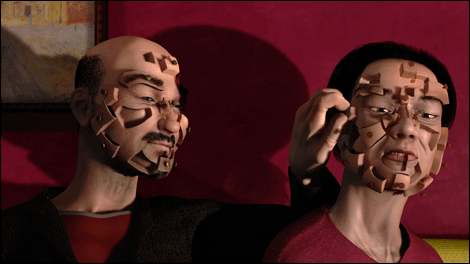 The Spine links Academy Award-winning director Chris Landreth to Seneca College once again.
The Spine links Academy Award-winning director Chris Landreth to Seneca College once again.
When Chris Landreth’s animated short Ryan won the Oscar in 2005, Seneca College in Toronto had special cause for pride. Ten graduates from the school’s Animation Arts Center had worked alongside Landreth in creating his innovative tribute to the troubled, late animator Ryan Larkin. Now Landreth is following up Ryan with The Spine, produced by the National Film Board of Canada in association with Copperheart Entertainment and C.O.R.E. Digital. And once again, Seneca graduates were on Landreth’s team, working alongside the pros at C.O.R.E., where the project was made.
Landreth explains how the collaboration came together. ‘I approached Steve Hoban from Copperheart around January ’07 with a 10-page script for a 10-minute film. It was a story about an unhappy marriage that takes place in a group therapy session.’ Given the complex human character animation in The Spine, Landreth felt the production would require a professional studio. ‘C.O.R.E. founder Bob Munroe got on board pretty quickly. Hat’s off to them, because doing a short film is certainly not lucrative.’
Landreth also approached Seneca’s Mark Jones and Sean Craig, who were developing a summer institute that would allow students to work on productions. Craig explains, ‘When Chris approached us, it spurred us on. We worked closely with C.O.R.E. and Chris to find ideal candidates. Our students presented cover letters, resumes and demo reels.’

Eight Seneca grads’with Craig as animation director’formed the main animation team on The Spine, which premiered at Annecy June 8. ‘They were involved in all stages of modeling, effects, lighting and rendering,’ says Landreth. ‘It was fortuitous that our schedule called for pretty much all the character animation to be done during Seneca’s summer break. It’s synchronicity, I guess.’
Since these were registered students, Craig explains, ‘They qualified for a work-study program offered by the Canadian government. So they were paid a subsidy that covered their tuition and they came out with money on top of that to live on.’ But Craig notes that the student workers devoted far more time than the subsidy covered. ‘Most of them were there six or seven days a week. And they were not shuffled off into a back room. They were on the floor with the other artists; with Chris’ desk in the middle. They weren’t babied. We had over 100 shots to finish in 16 weeks. And none of these students had ever worked in animation before.’
Landreth’s own expectations were exceeded. ‘We had planned a two-week ramp-up schedule when they got here, where they would get familiar with the models. We weren’t expecting them to do much work, but they instantly started animating the first shots. The first week we were getting production-quality work that’s in the film now. And we stayed consistently one or two weeks ahead of schedule. I was bowled over.’
The look Landreth wanted for The Spine required a sophisticated use of both Autodesk Maya (for modeling, animation and effects) and Side Effects’ Houdini (for its Mantra renderer). ‘I’ve made no attempt to do photorealism,’ he asserts. ‘These characters are clearly stylized and caricatured. But one of the cool things that we’ve been able to do at C.O.R.E. with both Maya and Houdini is to provide a micro-level or realism that I’ve never had before, even in Ryan. For example, the skin of the characters has a pretty uncanny appearance: There’s a lot of subsurface scattering and global illumination tricks. The look is gorgeous.’
The opportunity to break some technical ground existed for all the participants in The Spine. Seneca students, trained in Maya, had to learn how to prepare their work for rendering in Houdini. And Landreth himself is a Maya veteran, having created the the Oscar-nominated short film The End with the software. But working with C.O.R.E.’traditionally a Houdini shop’required creating a new pipeline. As Landreth explains, ‘We set up a pipeline to translate deftly between Maya and Houdini. I expect C.O.R.E. will be using it for a long time.’

That’s a residual outcome of The Spine which pleases Landreth, who wanted C.O.R.E. to enjoy some benefits from their great effort on his film. ‘When you’re doing a short film at a studio, you always look for some ‘value-added.’ Short films are basically tests for bigger things. That’s how I weasel people into doing my films in the first place. I justify it as a test bed!’
Landreth hopes that the Seneca students who’ve earned credits on The Spine will be able to parlay their experience to launch their professional careers, which is what happened for those who worked on Ryan. Not that there’s any pressure to follow in the footsteps of that success, laughs Craig, who recalls how Landreth ‘broke the ice’ with the Seneca students working on the short film. ‘One day Chris rode his bicycle to work with the Academy Award for Ryan in his backpack. In his very humble way he just said, ‘I thought you might like to see this.”
For more information and to see a trailer for The Spine, visit www.nfb.ca/thespine.












